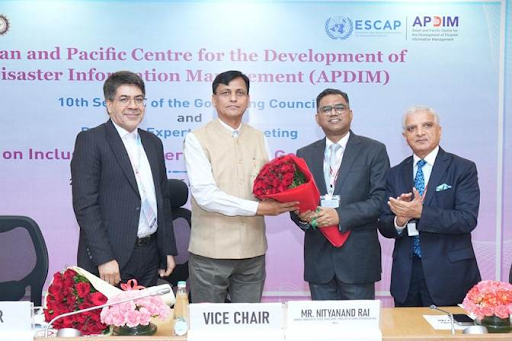Description
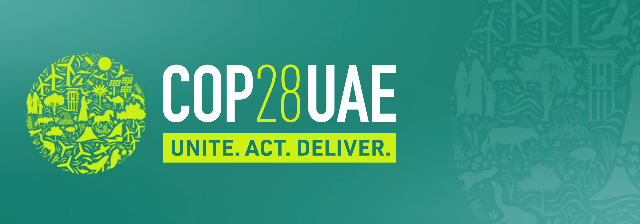
Disclaimer: Copyright infringement not intended
Context
India and COP
- India is an influential voice for developing countries at the annual COP events.
- Over the years, India has become more assertive and proposed some key measures.
Must Read Article: https://www.iasgyan.in/daily-current-affairs/climate-finance
India at COPs historically
- Right from the 1992 Rio de Janeiro Earth Summit, which gave rise to the UN Framework Convention on Climate Change (UNFCCC), India has been trying to ensure that the burden of climate action does not disproportionately fall on developing countries.
Common But Differentiated Responsibilities and Respective Capabilities (CBDR-RC)
- Indian negotiators played a lead role in the Kyoto Protocol at COP3 in 1997, which was based strongly on the principle Common But Differentiated Responsibilities and Respective Capabilities (CBDR-RC).
|
Common But Differentiated Responsibilities and Respective Capabilities (CBDR-RC)
One of the foundations of UNFCCC has been the principle of Common but Differentiated Responsibilities and Respective Capabilities (CBDR-RC), which emphasizes the point that while fighting climate change is everyone’s job, the rich and developed countries must bear the bulk of that responsibility, not just because they have caused most of the emissions but also because they have greater resources and capacity to act.
|

Paris Agreement
- The Kyoto Protocol was inherently unstable because of the restrictions placed on the rich countries.
- The CBDR-RC principle was gradually eroded in every COP decision.
- In this period — between 2008 and 2015, when the Paris Agreement was finalised — India’s main effort at the COPs was to prevent this erosion as much as possible.
|
Paris Agreement
The Paris Agreement allows every country, including those developed, to decide and implement its climate actions. Everyone is supposed to have a climate action plan (called Nationally Determined Contributions, or NDCs), but no mandatory targets. Only a marginal distinction between the developed and developing countries has been retained, that too informally.
|
India at the recent COPs
- In the past, India played its role largely in the background. This has changed in recent years, and New Delhi has become more assertive and more forthcoming in offering its own narrative.
- Also, after the Paris Agreement, as one of the fastest-growing economies, India’s conduct is tracked much more keenly.
- At the 2021 Glasgow meeting, India blocked the final draft outcome at the last minute and got the “phase-out” of coal changed to “phase-down”.
- At the Sharm el-Shaikh meeting last year, India campaigned for a phase-down of all fossil fuels, not just coal, a proposal that is still too hot to handle for many countries.
- India has also been energetically talking about the need for lifestyle changes to bring down energy consumption and emissions.
India’s Climate Commitments
- New Delhi has submitted two NDCs till now. The first NDC contained three targeted promises: India will reduce its emissions intensity, or emissions per unit of GDP, by 33 to 35% from 2005 levels by 2030; it will ensure that at least 40% of its installed electricity capacity in 2030 comprises of non-fossil-fuel sources; it will create at least 2.5 to 3 billion tonnes of additional carbon sink through tree and forest cover.
- In its updated NDC, announced last year, India raised the targets of the first two promises, having already achieved the previous targets eight years in advance. It raised the emission intensity reduction target to 4 %, and the non-fossil fuel-based electricity target to 50%.
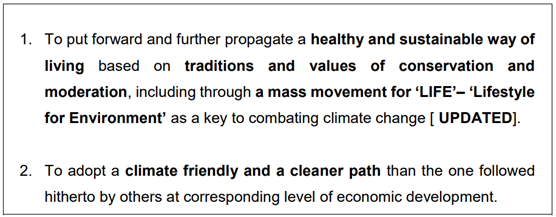
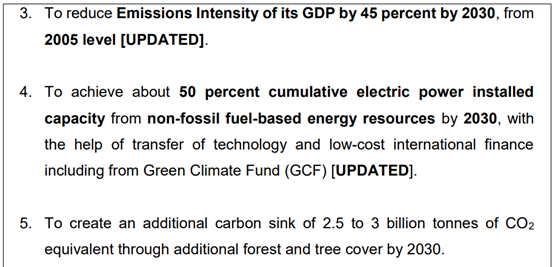
Indian Initiatives
- India has also launched some global initiatives on climate change that have received the backing of many countries. These initiatives are not part of the formal COP discussions but have been an important input.
International Solar Alliance (ISA)
- The International Solar Alliance (ISA), which seeks to promote the installation of solar energy across the world, was launched at the 2015 Paris meeting.
- The ISA has now evolved into a full-fledged UN-affiliated multilateral agency.
Coalition of Disaster Resilient Infrastructure (CDRI)
- A similar model is being followed for the Coalition of Disaster Resilient Infrastructure (CDRI), which seeks to become the global knowledge centre for creation of more resilient infrastructure.
- The CDRI has been receiving a lot of interest from developing countries, especially the small island states at maximum risk from climate disasters.
International Energy Agency (IEA)
- India also got the International Energy Agency (IEA) to do an analysis of its proposals.
- The IEA analysis shows that simple lifestyle changes had the capability to reduce annual global carbon dioxide emissions by about 2 billion tonnes by 2030.
- It also said that nearly 60% of these savings could be directly mandated by the governments.
LiFE (Lifestyle for Environment) Mission
- India’s LiFE (Lifestyle for Environment) Mission is now much more acceptable to other countries, and found its way in the final outcome of the G20 summit in New Delhi earlier this year.
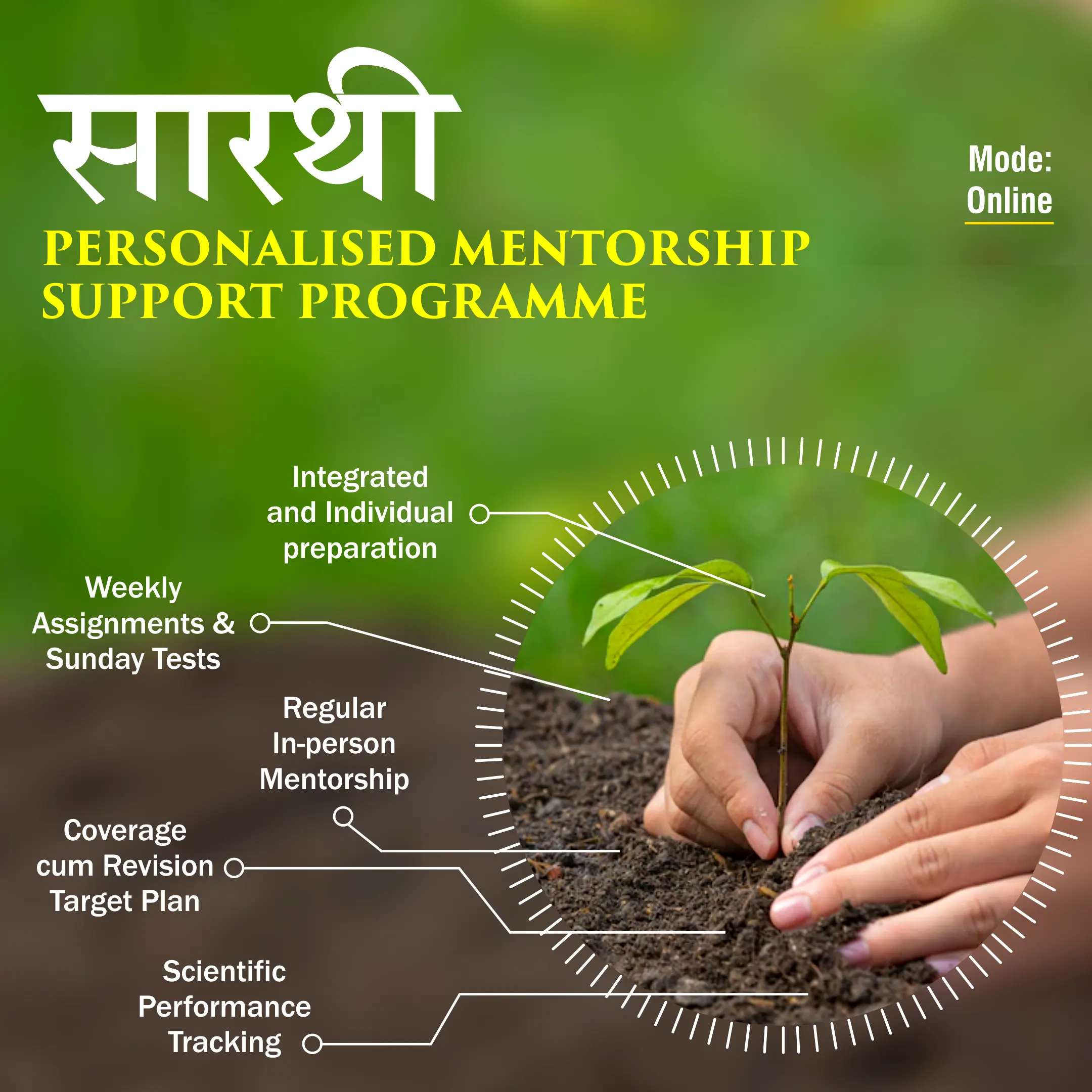
India’s Groups
- Since it is difficult to have all 190-plus countries present their individual points of view, negotiations at COPs happen mostly through formal and informal negotiating groups.
- Members of these groups finalize their common positions on different items, and these are presented at the formal negotiations.
- India has been one of the original members of what is known as the G77 group, of the developing countries.
- The name is a misnomer because the group has over 130 members now, almost the entire developing world.
- In more recent times, Brazil, South Africa, India and China formed the BASIC group, which has emerged as a powerful voice. India is also part of what is known as the Like-Minded Developing Countries (LMDC) bloc, which has about 20 large developing countries.
- India, like other countries, also becomes part of tactical groups that get together on specific issues from time to time.
MUST READ ARTICLE: https://www.iasgyan.in/daily-current-affairs/carbon-credits-market
MUST READ ARTICLE: https://iasgyan.in/blogs/all-about-intergovernmental-panel-on-climate-changeipcc
|
United Nations Climate Change Conferences
The United Nations Climate Change Conferences are yearly conferences held in the framework of the United Nations Framework Convention on Climate Change (UNFCCC). They serve as the formal meeting of the UNFCCC parties (Conference of the Parties, COP) to assess progress in dealing with climate change, and beginning in the mid-1990s, to negotiate the Kyoto Protocol to establish legally binding obligations for developed countries to reduce their greenhouse gas emissions.
Starting in 2005 the conferences have also served as the "Conference of the Parties Serving as the Meeting of Parties to the Kyoto Protocol" (CMP); also parties to the convention that are not parties to the protocol can participate in protocol-related meetings as observers. From 2011 to 2015 the meetings were used to negotiate the Paris Agreement as part of the Durban platform, which created a general path towards climate action. Any final text of a COP must be agreed by consensus.
The first UN Climate Change Conference was held in 1995 in Berlin.
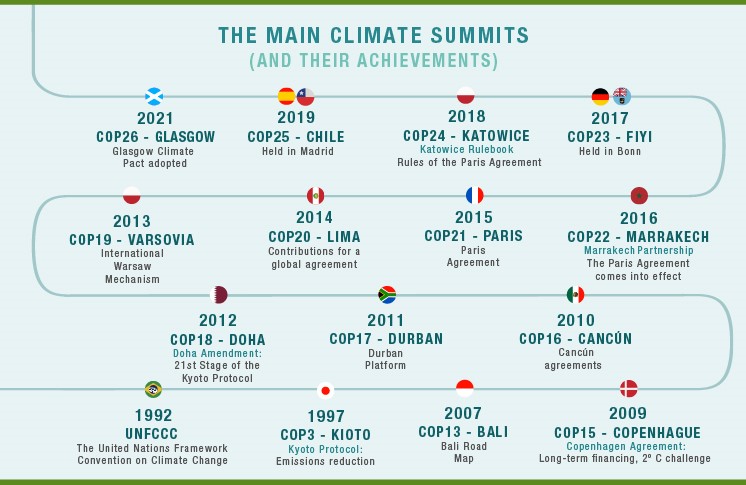
|
|
PRACTICE QUESTION
Q. India is an influential voice for developing countries at the annual COP events. What are India’s Climate Commitments and what role has India played in the recent Conference of the Parties (COPs).
|












